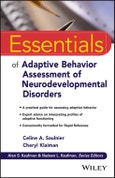A practical guide to adaptive behaviors across a range of neurodevelopmental disorders
Adaptive behavior assessment measures independent living skills, including communication, social skills, personal care, and practical work skills. For individuals with intellectual disabilities, evaluation of these skills is a critical tool for measuring eligibility and can identify specific skills that must be learned before effective educational interventions can be implemented. Essentials of Adaptive Behavior Assessment of Neurodevelopmental Disorders describes the role of adaptive behavior in assessment and treatment, and provides clear guidance for measurement. Case samples provide real-world illustration of behaviors and assessment, and systematic comparison of various measures are presented and explained to better inform planning.
Individual chapters outline specific adaptive behaviors across a range of neurodevelopmental disorders, giving clinicians, practitioners, students, and researchers a better understanding of diagnostic differentials and how to place independent skill programming in treatment and intervention.
- Plan intervention and treatment based on accessible measurement guidelines across a range of disorders
- Gain a deeper understanding of adaptive functioning specific to ADHD, autism spectrum disorders, disruptive behavior disorders, and genetic disorders
- Compare and contrast current measures to evaluate their strengths, weaknesses, and areas of overlap
- Quickly locate essential information with Rapid Reference and Caution boxes
For individuals with neurodevelopmental disorders, adaptive behaviors are the keys to independence; without them, these individuals will perpetually struggle with achieving optimum independence without the basic skills needed to function at home, in school, and in the community. Assessment allows these skills to be factored in to treatment and intervention planning, and can help improve the outcomes of other intervention methods. Essentials of Adaptive Behavior Assessment of Neurodevelopmental Disorders clarifies the assessment of these important behaviors, helping clinicians make more informed decisions around diagnosis, education, and treatment planning.
Table of Contents
Series Preface xv
Acknowledgments xvii
One Introduction and History of Adaptive Behavior 1
Introduction 1
The Birth of Adaptive Behavior 1
Adaptive Behavior in the Definition of Intellectual Disability 5
Principles of Adaptive Behavior 9
Summary 13
Test Yourself 14
Two Methods of Assessing Adaptive Behavior 17
Types of Measures 19
Interviews 20
Unstructured Interviews 20
Semi-Structured and Structured Interviews 21
Direct Observation 21
Checklists and Rating Scales 21
Self-Administered 22
Other-Administered 22
Purpose of Measure 24
Psychometric Properties 25
Floor and Ceiling Effects 25
Item Density 26
Reliability 26
Validity 27
Adequacy of Normative Samples 28
Sociocultural Biases 29
Choosing a Measure 30
Summary 30
Test Yourself 31
Three Standardized Measures of Adaptive Behavior 33
Vineland Social Maturity Scale 33
AAMD/AAMR/AAIDD Adaptive Behavior Scales 35
Adaptive Behavior Scale (ABS) 36
Adaptive Behavior Scale, Public School Version (ABS-PSV) 36
Adaptive Behavior Scale, School Edition, and AAMR Adaptive Behavior Scale–School:2 (ABS-S:2) 37
Diagnostic Adaptive Behavior Scale (DABS) 38
Vineland Adaptive Behavior Scales 40
Vineland Adaptive Behavior Scale (Vineland ABS) 40
Vineland Adaptive Behavior Scales, Second Edition (Vineland-II) 42
Vineland Adaptive Behavior Scales, Third Edition (Vineland-3) 43
Adaptive Behavior Assessment System 46
Adaptive Behavior Assessment System (ABAS) 47
Adaptive Behavior Assessment System, Second Edition (ABAS-II) 47
Adaptive Behavior Assessment System, Third Edition (ABAS-3) 49
Scales of Independent Behavior–Revised (SIB-R) 50
Adaptive Behavior Evaluation Scale, Third Edition (ABES-3) 51
Developmental Assessments with Adaptive Behavior Sections 52
Battelle Developmental Inventory, Second Edition, Normative Update (BDI-2) 53
Bayley Scales of Infant and Toddler Development, Third Edition (Bayley-III) 53
Summary 53
Test Yourself 55
Four Adaptive Behavior Profiles in Intellectual Disability and Genetic Disorders 57
Eligibility Versus Diagnosis 58
Adaptive Behavior Profiles by Level of Cognition in ID 60
Comorbidities with ID 61
Incidence and Prevalence of ID 62
Etiologies of ID 64
Genetic Causes of ID 65
Idiopathic and Biomedical Causes of ID 75
Summary 76
Test Yourself 77
Five Adaptive Behavior Profiles in Autism Spectrum Disorder 79
Relationship Between Adaptive Behavior and Levels of Cognition 80
Relationship Between Adaptive Behavior and Age 82
Relationship Between Adaptive Behavior and Autism Symptomatology 84
Relationship Between Adaptive Behavior and Sensory Behaviors 85
Relationship Between Adaptive Behavior and Sex 86
Adaptive Behavior Profiles in Toddlers and Preschool-Age Children with ASD 87
The Impact of Race, Ethnicity, and Socioeconomic Status on Adaptive Behavior in ASD 89
Summary 91
Test Yourself 91
Six Adaptive Behavior Profiles in Other Neurodevelopmental Disorders 93
Learning Disabilities 93
Attention Deficit/Hyperactivity Disorder (ADHD) 94
Obsessive Compulsive Disorder (OCD) 96
Movement and Motor Disorders 97
Developmental Coordination Disorder (DCD) 97
Inborn Errors of Metabolism (IEM) 98
Cerebral Palsy 98
Tourette’s Syndrome 98
Epilepsy 99
Hearing Impairments 100
Visual Impairments 101
Speech, Language, and Communication Disorders 102
Summary 103
Test Yourself 104
Seven Adaptive Behavior Profiles in Adults with Neurodevelopmental Disorders 107
Adaptive Profiles in Adults with Intellectual Disability 108
Adaptive Profiles in Adults with Genetic Disorders 110
Down Syndrome 110
Fragile X Syndrome 111
Williams Syndrome 112
Adaptive Behavior Profiles in Adults with Autism Spectrum Disorder 112
Adults with Language Impairments 115
Assessment for Intellectual Disability in Prisoners 116
The Relationship Between Adaptive Behavior and Residential and Vocational Success 119
Summary 121
Test Yourself 121
Eight The Role of Adaptive Behavior in Treatment and Intervention 123
Factors to Consider in Developing an Intervention Plan 124
Identifying Adaptive Behaviors to Target in Intervention 126
Evidenced-Based Practices for Treating Adaptive Behavior 130
Applied Behavior Analysis (ABA) 130
Naturalistic Developmental Behavioral Interventions (NDBIs) 133
Social Communication Approaches 134
Commercial Products 136
Summary 137
Test Yourself 138
Nine Case Samples 141
Case Sample 1: Individual with Intellectual Disability 141
Results 142
Sample Recommendations for Treatment of Adaptive Behavior 144
Case Sample 2: Individual with Autism Spectrum Disorder 145
Results 145
Sample Recommendations for ASD Educational Programming and Adaptive Behavior 148
Case Sample 3: Individual with Attention Deficit Hyperactivity Disorder 149
Results 149
Sample Recommendations for Treatment of Adaptive Behavior 153
Summary 154
References 157
About the Authors 183
Index 185







